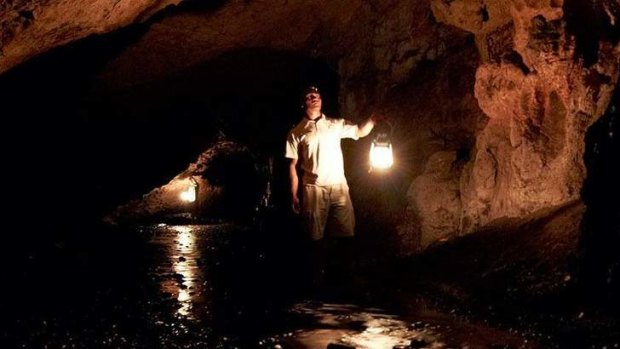By Craig Tansley

Going deeper: Naihehe Cave can be overwhelming for the senses.
Craig Tansley leaves luxury behind for an authentic underground experience in the footsteps of cannibals.
When the Sautabu people of Fiji grew tired of vegetables - and, let's face it, we all can - they'd strike an enemy warrior on the back of his head with a war club, leaving him paralysed. Next they'd roast him alive on a bed of burning taro leaves and distribute him among the villagers.
Such feasts stopped when the missionaries arrived in Fiji - cannibalism and Jesus didn't fit - but the Sautabu people stood firm. Tribes who opposed Christianity were forced into hiding and the Sautabu people had the best hiding spot in all of Fiji: Naihehe Cave, the country's largest cave system. There they hid from the missionaries and their converted warriors - in total darkness - for 79 days.
A century and a half later, visitors can enter Naihehe for the first time. The Off-Road Cave Safari tour is Fiji's newest cultural attraction - and the only one of its kind - allowing visitors to travel through the country's grisly history, far from the five-star resorts that hug the coast.
Just making it to Naihehe is a feat in itself. We drive along a narrow road from the town of Sigatoka on Viti Levu's Coral Coast across a landscape of primitive fruit and vegetable farms, then board a bilibili (punt) across the Sigatoka River. On the other side we're loaded into a rugged all-terrain vehicle. There are no paved roads on this side of the Sigatoka; instead we grind our way along a muddy, bumpy roller-coaster ride of a track that takes us through simple villages where children run out to wave. The locals in these hills had their first contact with the outside world only 50 years ago.
Life still seems remarkably simple; children ride past three-deep on horses, farmers plough fields using water buffalo and homes are largely wooden huts with thatched roofs. We're entering Fiji's highlands now: dark green mountains to the horizon, and around each corner the road plummets to the river far below.
When we arrive at the village beside the cave, we're required to ask permission to enter from the bete (priest) of the village. I strain to cross my legs on the hard concrete floor, then down cups of throat-numbing kava with the bete. The cave is at the end of a sun-lit jungle track; as we reach a dead end, a boy holds back a thick bundle of vines to reveal the cave's secret entrance.
The cave looks dark and wet; tiny swifts circle around my head, patrolling the entrance. After the oppressive heat of the jungle, the cool of Naihehe helps negate my phobias of birds and confined spaces. The entrance is tight but it's nothing compared with the next barrier - the pregnancy gap. Here I must hold a bamboo handle and slide through a tiny gap in the limestone with only my head and shoulders above the waterline. Once inside, my head-lamp illuminates a huge, silent chamber.
Naihehe is 170 metres long; dagger-shaped stalactites hang from a 150-metre-high ceiling. It was here that Sautabu warriors stood guard for 79 days; as enemy warriors squeezed through the pregnancy gap the guards struck them on the back of the head.
Naihehe comes with its own indoor oven, chiselled out over millions of years as water dripped from the cave's ceiling. Warriors would drag the paralysed victims here to roast. Beside the oven sits a ritual platform where live sacrifices were conducted on behalf of the village priest.
There's an eerie feel to this place. When we turn off our head-lamps for just a few seconds the darkness, and the silence, overwhelms me. The Sautabu people hid like this, living off freshwater prawns and human flesh, silent, lest their voices carry outside.
The cave extends far beyond what we see. American divers used diving equipment and ropes to go beyond this chamber a decade ago; they journeyed for eight hours and still didn't reach the end. Along the way, they encountered eels the width of their thighs.
We leave the cave and walk through a village to lunch beside a freshwater swimming hole where children play and farmers bring water buffalo to drink.
There's nothing fancy about this tour. We arrive with no fanfare and there are none of the obligatory dances or arts-and-crafts stalls of many cultural tours and, with numbers limited to 10 (in two ATVs), it feels far less intrusive and voyeuristic.
On the coast, visitors can feel smothered by other tourists, but here in the highlands it's possible to escape into a Fiji you won't experience in any five-star resort.
The writer travelled courtesy of Off-Road Cave Safari tours, Air Pacific and Shangri-La's Fijian Resort & Spa.
TRIP NOTES
GETTING THERE
Fiji Airways (Air Pacific) flies daily from Sydney and Brisbane to Fiji and regularly from Melbourne from $690 return. See fijiairways.com.
STAYING THERE
Stay close to Sigatoka on Fiji's Coral Coast at the Shangri-La resort. See shangri-la.com/yanucaisland/fijianresort.
TOURING THERE
Tours operate twice daily, at 8.30am and 1pm. Adults cost $F239 ($140), $F110 for children, with pick-up from Coral Coast resorts. See offroadfiji.com.
MORE INFORMATION
Sign up for the Traveller Deals newsletter
Get exclusive travel deals delivered straight to your inbox. Sign up now.